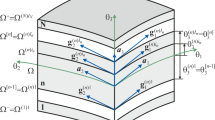Abstract
The line-spring model is an efficient tool introduced by Rice and Levy [1] for the approximate analysis of surface flaws in plates and shells. A finite element implementation of the linear elastic line-spring was reported by Parks et al. [2]. The stress intensity factors obtained using this model were in close agreement to those calculated through three-dimensional continuum finite element solutions. Extensions of the model to elastic-plastic crack analysis have been undertaken by Parks and co-workers [3, 6, 7] using the incremental theory of plasticity. The deformation theory of plasticity is employed in the current formulation, and a Ramberg-Osgood description of the material is assumed. Further, we make use of the asymptotic results obtained by Shih and Hutchinson [4] for a small ligament subject to an arbitrary combination of tension and bending. An effective crack depth is taken into account in the elastic part of the current line-spring model. Numerical solutions are presented for a number of 3-D structural problems with surface cracks. Comparisons of the model's predictions with relevant continuum solutions are presented. Finally, we report observations regarding the shift of the loading axis with increasing loads. This phenomenon plays an important role in the discussion of HRR-dominance and the possible use of the J-integral as the single parameter for the characterization of crack tip fields.
Résumé
Le modèle de ressorts en ligne est un outil efficace introduit par Rice et Levy pour l'analyse approximative des défauts de surface dans les tôles et les coques. Une présentation par éléments finis d'une ligne de ressorts en condition linéaire élastique a été proposée par Parks et al. Les facteurs d'intensité de contraintes obtenus en utilisant ce modèle ont été trouvés en bon accord avec les valeurs calculées au moyen de solution par éléments finis dans un continuum tridimensionnel. Parks et ses associés ont entrepris d'étendre le modèle à l'analyse d'une fissure élasto-plastique, en utilisant la théorie incrémentielle de la plasticité. On utilise, dans la formulation existante, la théorie de la déformation en plasticité et on suppose que le matériau correspond à une description de Ramsberg-Osgood. En outre, on fait usage des résultats asymptotiques obtenus par Shih et Hutchinson dans le cas d'un petit ligament sujet à une combinaison arbitraire de traction et de flexion. On prend en compte une profondeur effective de fissure dans la partie élastique, du modèle en ressorts alignés utilisés. Des solutions numériques sont présentées pour plusieurs problèmes structuraux à trois dimensions comportant des fissures de surface. On compare les prédictions du modèle avec des solutions relatives à un continuum comparable. Enfin, on apporte des observations relatives au glissement de l'axe de mise en charge lorsque les charges augmentent. Ce phénomène joue un rôle important dans une discussion sur l'utilisation possible de l'intégrale J comme paramètre simple, en vue de caractériser des champs à l'extrémité d'une fissure.
Similar content being viewed by others
References
J.R. Rice and N. Levy, Journal of Applied Mechanics 39 (1972) 185–194.
D.M. Parks, R.R. Lockett and J.R. Brockenbrough, in Advances in Aerospace Structures and Materials, S.S.Wang and W.R.Renton (eds.) AD-01, ASME, N.Y. (1981) 279–285.
D.M. Parks and C.S. White Journal of Pressure Vessel Technology 104 (1982) 287–292.
C.F. Shih and J.W. Hutchinson Journal of Applied Mechanics 53 (1986) 271–277.
5. N. Levy and J.R. Rice, “Surface cracks in elastic plates and shells”, unpublished manuscript (1972).
D.M. Parks Journal of Pressure Vessel Technology 103 (1981) 246–254.
D.M. Parks, in Advances in Fracture Research (Fracture 1981), D.Francois (ed.) 5, Pergamon, Oxford (1981) 2589–2598.
8. D.M. Parks and R.R. Lockett in EPRI Ductile Fracture Research Review Document, Report EPRI NP-80–10-LD, WS 80–912 (December, 1980) 9.1–9.12.
F. Delale and F. Erdogan, International Journal of Engineering Science 19 (1981) 1331–1340.
T. Miyoshi, M. Shiratori and Y. Yoshida, Journal of Pressure Vessel Technology 108 (1986) 305–311.
V. Kumar and M.D. German, Journal of Pressure Vessel Technology 108 (1986) 412–420.
C.F. Shih and A. Needleman, ASME Journal of Applied Mechanics 51 (1984) 48–56.
J.R. Rice, International Journal of Solids and Structures 8 (1972) 751–758.
G.R. Irwin, in Handbuch der Physik VI, S.Flugge (ed.) Springer, Berlin (1958) 551–590.
15. C.F. Shih, W.R. Andrews, H.G. deLorenzi, M.D. German, R.H. Van Stone and D.F. Mowbray, “Methodology. for plastic frature”, General Electric Final Report to Electric Power Research Institute, Publication No. EPRI-1735 (1981).
16. V. Kumar, M.D. German, W.W. Wilkening, W.R. Andrews, H.G. deLorenzi and D.F. Mowbray, “Advances in Elastic-Plastic Fracture Analysis”, EPRI NP-3607 (1984).
T. Nakamura and T.G. Shawki, International Journal of Fracture 35 (1987) R15-R21.
I.S. Raju and J.C. NewmanJr., Engineering Fracture Mechanics 11 (1979) 817–829.
C.F. Shih, International Journal of Fracture 29 (1985) 73–84.
20. R.M. McMeeking and D.M. Parks in Elastic-Plastic Fracture, ASTM STP 668 (1979) 175–194.
C.F. Shih and M.D. German, International Journal of Fracture 17 (1981) 27–43.
Author information
Authors and Affiliations
Rights and permissions
About this article
Cite this article
Shawki, T., Nakamura, T. & Parks, D. Line-spring analysis of surface flawed plates and shells using deformation theory. Int J Fract 41, 23–38 (1989). https://doi.org/10.1007/BF00014835
Received:
Accepted:
Issue Date:
DOI: https://doi.org/10.1007/BF00014835




